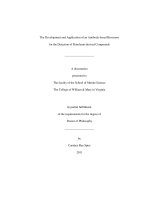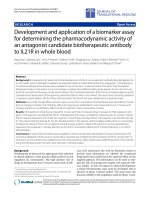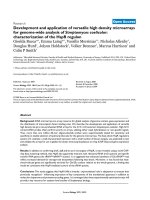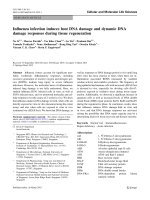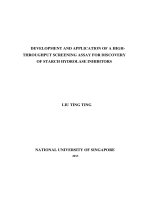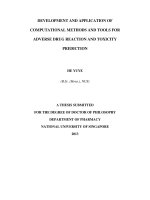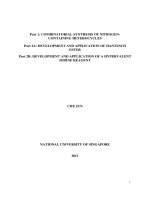Development and application of a dot elisa assay for diagnosis of southern rice black streaked dwarf sisease in the field (khóa luận tốt nghiệp)
Bạn đang xem bản rút gọn của tài liệu. Xem và tải ngay bản đầy đủ của tài liệu tại đây (1.21 MB, 74 trang )
VIETNAM NATIONAL UNIVERSITY OF AGRICULTURE
FACULTY OF BIOTECHNOLOGY
-------oOo-------
UNDERGRADUATE THESIS
TITLE:
DEVELOPMENT AND APPLICATION OF A DOTELISA ASSAY FOR DIAGNOSIS OF SOUTHERN RICE
BLACK-STREAKED DWARF DISEASE IN THE FIELD
HANOI, 3/2020
VIETNAM NATIONAL UNIVERSITY OF AGRICULTURE
FACULTY OF BIOTECHNOLOGY
-------oOo-------
UNDERGRADUATE THESIS
TITLE:
DEVELOPMENT AND APPLICATION OF A DOTELISA ASSAY FOR DIAGNOSIS OF SOUTHERN RICE
BLACK-STREAKED DWARF DISEASE IN THE FIELD
Student
: La Duc Duy
Class
: K61CNSHE
Faculty
: Biotechnology
Supervisors
: Nguyen Duy Phuong, PhD
Bui Thi Thu Huong, PhD
HANOI, 3/2020
COMMITMENT
I would like to assure that this thesis was completely conducted by scientific
researches by myself under the guidances of Dr. Nguyen Duy Phuong Department of Plant Molecular Pathology, part of Agricultural Genetics Institute
and Dr. Bui Thi Thu Huong - Faculty of Biotechnology, Vietnam National
University of Agriculture, I assure you that this is my own research. The data and
results stated in the thesis are honest and have not been published in any other
research project.
I assure you that the information quoted in the thesis has been clearly
indicated with the source, with the quotation in accordance with the regulations.
I take full responsibility for this assurance.
Ha Noi, March, 2021
Student
La Duc Duy
i
ACKNOWLEDGEMENTS
To complete my graduation thesis, in addition to my hard work, I have also
received a lot of dedicated helps and guidances from others.
First and foremost, I would like to express my sincere gratitude to my
advisors Dr. Nguyen Duy Phuong and Dr. Bui Thi Thu Huong for their continuous
support of my study and research, for being patient, enthusiastic, and
knowledgable. Their guidances have helped me in all the time of research and
writing of this thesis. I could not have imagined having better advisors and mentors
for my study. After having been taken under their wings, I can feel that I have
grown not only as an inspired student but also as a man.
My sincere thanks also go to Assoc. Prof. Ha Viet Cuong from our
univiersity, MSc. Phung Thi Thu Huong, and other people in molecular pathology
department, of Agriculture Genetic Institute for offering me an opportunity to work
along side them and leading me on my very first project.
Last but not the least, I would like to appreciate my family, my friends for
supporting me mentally throughout my work.
ii
Contents
COMMITMENT ........................................................................................................... i
ACKNOWLEDGEMENTS ......................................................................................... ii
LIST OF FIGURE .........................................................................................................v
LIST OF TABLE ......................................................................................................... vi
LIST OF ABBREVIATIONS .................................................................................... vii
INTRODUCTION .........................................................................................................1
PART I. OVERVIEW ...................................................................................................3
1.1. Harmful rice viruses .........................................................................................3
1.2. Southern rice black-streaked dwarf virus ......................................................4
1.2.1. The origin of SRBSDV ................................................................................4
1.2.2. Pathological characteristics of SRBSDD ...................................................6
1.2.3. Biological characteristics of SRBSDV ........................................................8
1.3. Diagnosis and detection of SRBSDV .............................................................10
1.3.1. RT-PCR ......................................................................................................10
1.3.2. Enzyme-linked immunosorbent assay .......................................................13
1.4. SRBSDV in Vietnam .......................................................................................15
1.4.1. A history of SRBSDD in Vietnam .............................................................15
1.4.2. SRBSDV researches in Vietnam ...............................................................17
PART II. MATERIALS AND METHODS ................................................................20
2.1. Research subject ..............................................................................................20
2.2. Materials, chemicals and equipment .............................................................20
2.2.1. Materials .....................................................................................................20
2.2.2. Chemicals ...................................................................................................21
2.2.3. Equipment ..................................................................................................21
iii
2.2. Methods ............................................................................................................21
2.2.1. RNA extraction and quantification ...........................................................21
2.2.2. Protein extraction and quantification .......................................................23
2.2.3. Evaluation of anti-SRBSDV antibodies ....................................................26
2.2.4. Statistical analysis ......................................................................................26
2.2.5. Optimization of chemical components for SRBSDV test .........................27
2.2.6. Optimization of dot-ELISA assay for SRBSDV diagnosis .......................29
2.2.7. Experimentation of optimized dot-ELISA for SRBSDV diagnosis .........30
2.2.8. Assessment of shelf life of SRBSDV diagnostic kit ..................................31
2.2.9. Assessment of sensitivity and specificity of SRBSDV diagnostic kit .......31
PART III. RESULTS AND DISCUSSIONS ..............................................................32
3.1. Assessment of anti-SRBSDV antibodies .......................................................32
3.1.1. Assessment of anti-SRBSDV antisera.......................................................32
3.1.2. Assessment of anti-P10 antibody...............................................................33
3.2. Optimization dot-ELISA assay for SRBSDV diagnosis ..............................35
3.2.1. Optimization of dot-ELISA assay ..............................................................35
3.2.2. Diagnosis of SRBSDV with optimized dot-ELISA assay .........................48
3.3. Development of dot-ELISA kit for SRBSDV diagnosis...............................51
3.3.1. Production of the dot-ELISA kit ...............................................................51
3.3.2. Specificity and sensitivity of SRBSDV dot-ELISA kit ..............................52
3.3.3. Assessment of the shelf life of SRBSDV dot-ELISA kit...........................54
PART IV. CONCLUSIONS AND SUGGESTIONS..................................................56
4.1. Conclusion ........................................................................................................56
4.2. Suggestion ........................................................................................................56
REFERENCES ............................................................................................................57
iv
LIST OF FIGURE
Figure 1.1. Symptoms of SRBSDV-infected rice…………………………………..7
Figure 3.1. Titer of the four anti-SRBSDV antisera................................................32
Figure 3.2. Titer of anti-P10 antibody assessed by dot-ELISA…………………...34
Figure 3.3. Specificity of anti-P10 antibody……………………………………....35
Figure 3.4. Effect of primary antibody dilution on SRBSDV dot-ELISA test…....36
Figure 3.5. Effect of secondary antibody dilution on SRBSDV dot-ELISA test…37
Figure 3.6. Effect of different buffers on SRBSDV dot-ELISA test……………...38
Figure 3.7. Effect of blocking solution on SRBSDV dot-ELISA test…………….39
Figure 3.8. Effect of NaN3 on SRBSDV dot-ELISA test........................................40
Figure 3.9. Effect of TWEEN-20 on SRBSDV dot-ELISA test………………….42
Figure 3.10. Effect of sampling procedure on SRBSDV dot-ELISA test………...43
Figure 3.11. Effect of sample storage condition on SRBSDV dot-ELISA test…...44
Figure 3.12. Chlorophyll removal efficiency of methanol treatment……………..45
Figure 3.13. Effect of blocking duration on SRBSDV dot-ELISA test…………..46
Figure 3.14. Effect of primary antibody incubation duration on SRBSDV dotELISA test…………………………………………………………………...47
Figure 3.15. Effect of secondary antibody incubation duration on SRBSDV dotELISA test…………………………………………………………………...48
Figure 3.16. SRBSDV diagnosis with RT-PCR method………………………….49
Figure 3.17. SRBSDV diagnosis with optimized dot-ELISA assay………………49
Figure 3.18. SRBSDV dot-ELISA kits……………………………………………51
Figure 3.19. Specificity of dot-ELISA-based SRBSDV diagnostic kit…………...53
Figure 3.20. Sensitivity of the SRBSDV dot-ELISA kit………………………….53
Figure 3.21. Effect of preservation period on SRBSDV dot-ELISA test…………54
v
LIST OF TABLE
Table 2.1. Oligonucleotide sequences used in the study………………………….20
Table 2.2. SDS-PAGE 12% gel preparation………………………………………23
Table 3.1. Results of SRBSDV diagnosis with optimized dot-ELISA assay……..49
Table 3.2. Components of dot-ELISA kit…………………………………………52
vi
LIST OF ABBREVIATIONS
AGI
Agricultural Genetics Institute
ANOVA
Analysis of variance
APS
Ammonium persulfate
AP
Alkaline phosphatase
BCIP
5-bromo-4-chloro-3-indolyl phosphate
BPH
Brown WBPH
BSA
Bovine serum albumin
cDNA
Complementary DNA
DAS-ELISA
Double antibody sanwich ELISA
DEPC
Diethyl pyrocarbonate
Dot-ELISA
Dot - enzyme-linked immunosorbent assay
EDTA
Ethylenediaminetetraacetic acid
ELISA
Enzyme-linked immunosorbent assay
EtBr
Ethidium bromide
FDV
Fiji disease virus
IRRI
International rice research institute
MAb
Monoclonal antibody
MARD
Ministry of Agriculture and Rural Development
MRDV
Maize rough dwarf virus
NBT
Nitro blue tetrazolium
PAb
Polyclonal antibody
PBS
Phosphate-buffered saline
PPD
Plant protection department
PPRI
Plant Protection Research Institute
vii
PVDF
Polyvinylidene fluoride
RT-PCR
Reverse transcription polymerase chain reaction
RBSDV
Rice black-streaked dwarf virus
RBSDV-2
Rice black-streaked dwarf virus-2
RDV
Rice dwarf virus
RGSV
Rice grassy stunt virus
RHBV
Rice hoja blanca virus
RNMV
Rice necrosis mosaic virus
RRSV
Rice ragged stunt virus
RTYV
Rice transitory yellowing virus
RTBV
Rice tungro bacciliform virus
RYDD
Rice yellow dwarf disease
RYSV
Rice yellow stunt virus
RT
Room temperature
SBPH
Small brown planthopper
SDS – PAGE
Sodium dodecyl sulfate–polyacrylamide gel electrophoresis
SRBSDD
Southern rice black-streaked dwarf disease
SRBSDV
Southern rice black-streaked dwarf virus
SD
Standard deviation
TAE
Tris-acetate-EDTA
TBS
Tris-buffered saline
UV
Ultra violet
WBPH
White-backed planthopper
viii
INTRODUCTION
Vietnam is one of the largest rice-producing countries in the world. Thus,
rice producing is vital for about 70% of the agricultural population and for the food
security of the nation. However, rice production is heavily affected by factors such
as the loss of area of cultivation, diseases, climate change. Virus is one of the most
dangerous pathogens and is also the cause of instability in rice production and
endangered food security, especially with how climate change helps spreading
virus diseases with growing frequency and virulent. Virus diseases when happened
often cause detrimental effects, which can occur in-turn and re-emerge after a
certain period of time. The annual losses caused by WBPH and virus diseases are
approximately billions of Vietnam Dong.
Southern rice black-streaked dwarf virus (SRBSDV) was first observed in
Guangdong province in 2001 and identified in 2008. In Vietnam, SRBSDV was
observed in 2009 and caused major losses on thousands of hectares in North and
Central Vietnam. The disease also caused extensive crop damage in 2010, but soon
disappeared, and then reemerged strongly in 2017. The SRBSDV is transmitted by
white-backed planthopper (WBPH), and the main mode of transmission is the
feeding process rather than spawning. For SRBSDV, it is ineffective to start
control the disease when rice plants have already shown the symptoms. Early
detection of the virus content in plant samples (symptomatic/asymptomatic) does
not bring much significant difference to disease control either. On the contrary,
early detection of viruliferous WBPHs in the field is tremendously valuable to
southern rice black-streaked dwarf disease (SRBSDD) control that allows farmers
to actively eliminate WBPHs, which minimize the risk of SRBSDD emergence.
The current laboratory diagnosis of SRBSDV disease employs reverse
transcription polymerase chain reaction (RT-PCR) and immunoassays to detect
viral RNA in plant samples. Diagnosis by RT-PCR can achieve results with high
1
accuracy, but comes at a high price, and requires a trained laboratory technician
that makes it unable to be applied on a large scale. Meanwhile, immunoassays also
provide reliable results with reasonable price, which fits perfectly with the
economic situation in Vietnam.
The challenging aspect of developing a SRBSDV diagnostic kit based on
antigen-antibody interaction is to be able to produce a specific antibody with
enough sensitivity to detect SRBSDV in rice plant and WBPH samples. While
SRBSDV quick stick test is not available because of the limit of monoclonal
antibody (MAb) technology, SRBSDV enzyme-linked immunosorbent assay
(ELISA) using polyclonal antibody (PAb) is more compatible with virus diagnosis
in Vietnam, in comparison with RT-PCR test. Essentially, Dot-ELISA is a simple,
rapid and scalable procedure for screening a large number of samples at one time.
The overall aim of this study is to successfully develop a specific and
sensitive diagnostic kit for SRBSDV at a reasonable price. In order to achieve such
goal, several requirements need to be attained, including:
Dot-ELISA assay is conducted with optimized protocol so that
visible dots have clear, bright color with no background.
Anti-SRBSDV antibody is specific and sensitive to SRBSDV.
Expression of desired P10 protein can be used as positive
control in dot-ELISA assay.
Infected rice plant and viruliferous WBPH samples can be seen
after color development and virus-free rice and WBPH samples must not
exhibit any signal.
2
PART I. OVERVIEW
1.1. Harmful rice viruses
Rice-infecting viruses have been persistent and are considered one of the
most dangerous threats to rice plants at global scale, especially Vietnam. However,
it was not until 1895 that the Japanese scientists began to tackle this problem and
for the first time, Rice dwarf virus (RDV) was identified. After that, Rice blackstreaked dwarf virus (RBSDV) was identified (Shinkai, 1958) and many other riceinfecting viruses as well like Rice tungro bacciliform virus (RTBV), Rice
transitory yellowing virus (RTYV), Rice necrosis mosaic virus (RNMV), Rice
ragged stunt virus (RRSV), Rice grassy stunt virus (RGSV), Rice hoja blanca virus
(RHBV), etc (Hibino, 1979). Until now, although there is about 30 rice-infecting
viruses has been reported, but only 5 of them are common and causing major
damages on rice plants (RGSV, RRSV, RTBV, RBSDV, and RTYV) (Hibino,
1996; Zhou et al., 2008).
In Vietnam, rice-infecting virus disease has caused damage for crops since
1910 in Northern Vietnam, but it was not until 1963 that there was a report of
yellowing on rice and in 1965, virus was identified as the cause of transitory
yellowing and vector for transmission was green paddy leafhopper. In 1979, the
first rice ragged stunt virus image was taken on electron microscopes and followed
by investigative, identifying studies and artificial innoculation of rice virus. The
development of science and technology has taken researches on rice viruses in
Vietnam to the next step as diagnostic methods are becoming more and more
diverse such as antiserological methods and PCR method (Vu Trieu Man et al.,
2003). In 2006, the cause of Rice yellow dwarf disease (RYDD) in the Mekong
Delta was determined as a combination of three viruses: RGSV, RRSV and Tungro
spherical virus. This discovery was also verified by International Rice Research
Institute (IRRI) specialists using antisera of these three (Pham Van Du, 2006). In
3
2006, the epidemic of rice yellow dwarf and rice ragged stunt disease broke out
across Mekong Delta provinces with an infected rice area of about 500,000
hectares and caused a total loss of about 2,000 billion VND. In 2009, a new virus
called SRBSDV caused black-striped dwarf disease in 20 northern and central
provinces with a total infected area of more than 42,000 hectares.
All rice viruses found in Vietnam are of economic importance and spread
through hoppers. The diagnosis is often difficult because the symptoms can be
confused by the use of herbicide or physiological effects. Virus detection on
WBPH requires diagnostic techniques such as ELISA or PCR.
1.2. Southern rice black-streaked dwarf virus
1.2.1. The origin of SRBSDV
In 2001, a new rice stunt disease was first observed on rice plants (Oryza
sativa) in Guangdong, Southern China. Infected plants had typical symptoms
caused by RBSDV, namely visibly stunted growth, dark green leaves, most
noticeably galls in form of black striped running along the veins on leaves, sheaths,
and columns, and the missing of adventitious roots. RT-PCR using specialized
primer bound to the S10 fragment of RBSDV multiplied a gene fragment of 850
bp. However, this gene sequence was only 80% similar to the respective gene of
RBSDV. Therefore, the virus was first considered a mutation of RBSDV (Zhou et
al., 2004).
RBSDV continued to spread to provinces of Southern China. In 2008, Zoul
et al. journal of South China Agricultural University published the result of gene
analysis on S9 and S10 fragments of this strand of RBSDV in Hainan Island, China
(sampled in 2003). The finding showed that the S9 and S10 fragments of this
strand of virus only yielded a similarity of 68.8% to 74.9% and 67.1% to 77.4%,
respectively, with their counterparts in group two of Fijivirus, including RBSDV.
On the other hand, similarity within the RBSDV population was much higher
4
(>90%). Authors of Zoul et al. also conducted disease-spreading experiment and
identified the main vector of this disease: white-backed WBPHs (Sogatella
furcifera). Based on this study, RBSDV in Hainan Island was named SRBSDV
(Zhou et al., 2008).
At the same time, Zhang et al. journal of Zhejiang Academy of Agricultural
Sciences also sequenced all four segments S7 - S10 of a black-striped rice disease
virus in Guangdong province (collected in 2005). The sequence comparison also
showed that the virus was different from RBSDV and assumed that it was a new
species called RBSDV-2 (Zhang et al., 2008).
The virus vector studies of Zhou et al. (2008) showed that the vector of this
virus was WBPHs, completely different from the RBSDV vector. Combining with
the analysis of the entire genome, the cause of black-striped dwarf disease in
Hainan and Guangdong provinces was concluded to be a new virus belonging to
group 2, most closely related to RBSDV and Maize rough dwarf virus (MRDV), in
genus Fijivius, Reoviridae family named SRBSDV (Wang et al., 2010). The name
SRBSDV was due to the similarity of symptoms in infected plants, but RBSDV
concentrates mainly in the northern hemisphere while SRBSDV only records in
southern provinces of China. Moreover, the disease vector is WBPHs, which are
present in southern China while small brown planthopper (SBPH), the vector of
RBSDV, are more common in Northern China (Wang et al., 2010).
So far, although the International Committee on Taxonomy of Viruses has
not officially approved SRBSDV as a new species (Attoui, 2011), but the scientific
community has accepted the name of the virus as well as its status as a new virus.
After being identified as the cause in 2008, SRBSDV continued to spread to
the southern provinces of China. In 2009, the disease appeared in 9 southern
provinces of China with the infected area of 315,000 ha, and reached its peak in
5
2010 with a total of 13 infected southern provinces of China which accumulated
over 1,300,000 ha (Zhou et al., 2010; Zhai et al., 2011).
The disease also appeared in rice in southern Japan in 2010 due to the
migration of WBPHs carrying the virus from China (Matsukura et al., 2013).
In Vietnam 2009, the black-streaked dwarf disease was first detected in rice
in 20 provinces in Northern and Northcentral Vietnam, the infected area was up to
42,000 ha (Ngo Vinh Vien et al., 2009). Molecular studies based on S10 segment
sequences, electron microscopy and symptomatology has identified SRBSDV as
the causative agent (Ha Viet Cuong et al., 2009).
1.2.2. Pathological characteristics of SRBSDD
SRBSDV-infected rice is relatively short with dark green leaves, twisted
leaves or splitting margin leaves, and especially with waxy white-to-black galls
along the veins on the underside of leaf blades and the outer surface of sheaths and
columns. These galls form due to the overwhelming growth in both the number
and size of phloem tissues. In the early stages, the main vein of vagina is swollen.
In the seedling development stage, infected plants generally bud on stems and
grow many adventitious roots. Seriously infected rice are unable to bloom
properly, and have blackened seeds (Figure 1.1). Stunting growth and white
twisted leaves only appear in the early stage; while stunted growth is very difficult
to detect in infected rice plants after tillering, the inability to bloom and having
black imperfect grain are typical (Ha et al., 2009; Matsukura et al., 2013; Zhou et
al., 2008; Zhou et al., 2013).
In general, the disease symptoms caused by RRSV, RBSDV, and SRBSDV
are quite similar. The biggest difference is that waxy white-to-black galls along the
veins on the underside of leaf blades and the outer surface of sheaths and columns
only appear in RBSDV- and SRBSDV-infected rice plants.
6
The main transmission vector is WBPH (Sogatella furcifera). Both young
and adult WBPHs are able to transmit the virus. WBPH can transmit the virus
throughout its lifecycle after feeding on infected plants. A research on the
transmission of SRBSDD was conducted to assess the ability to transmit SRBSDV
with three different vectors: WBPH (Sogatella furcifera), brown planthopper
(BPH) (Nilaparavata lugens), SBPH (Laodelphax striatellus). The result indicated
that both WBPH and SBPH were able to transmit SRBSDV from rice plant to rice
plant at an extremely high rate (100% with only 3 to 4 PH per plant). However,
only WBPH could transmit SRBSDV from rice plant to maize. This research also
found out that BPH cannot transmit SRBSDV.
Figure 1.1. Symptoms of SRBSDV-infected rice. (a) Rice plant was relatively
short with dark green leaves, and (b) twisted rice leaves. (c) There were waxy
white galls along the veins of the leaf, (d) leaf blades, (e) and stem stings. (f) The
white galls turned from brown to black. (g) Plants were unable to bloom properly.
(Ha et al., 2009).
Another research about the characteristics of SRBSDV transmission by
WBPH was also carried out by Chinese scientists to identify different
developmental stages of the disease, and also to find out the most effective way to
control this disease. By using RT-PCR method, they identified the presence of
SRBSDV in all developmental stages of S. furcifera, including: nymph and adult.
7
Viruliferous WPBHs could transmit the virus throughout their lifecycle but they
could not transmit the virus in egg stage. Each viruliferous WBPH individual could
infect 48-50 rice plants, up to 87-90 plants. The minimum and maximum time for
WBPH to transmit the virus was 5-7 minutes and 10-12 minutes, respectively,
depending on different developmental stages of the plant. The result also indicated
that young rice plant was the most susceptible stage to virus transmission from
WBPH.
Apart from rice plant, other plants, such as Coix lacryma-jobi, Avena fatua,
Echinochloa crusgalli, Eleusine indica, and Pennisetum flaccidum have also been
indentified as SRBSDV’s natural hosts. Infected maize is stunted, with dark green
leaves, and waxy galls at the veins of leaves. On other infected plants, leaves can
turn dark green and get twisted (Zhou et al., 2008; Zhou et al., 2012).
1.2.3. Biological characteristics of SRBSDV
SRBSDV genome has a length of 29,124 bp, consists of 10 double-stranded
RNA segments, ranging in size from 1.8 to 4.5 kb named in the order from S1 to
S10 based on the double-stranded RNA segment size.
The S1 segment has a length of 4,500 bp, encodes a polypeptide (containing
functional regions of RNA polymerase) with a molecular weight of 169 kDa. The
S2 segment has a length of 3,815 bp, contains an ORF that encodes a viral
envelope protein with a molecular weight of 141 kDa (undefined function). The S3
segment has a length of 3,618 bp, contains an ORF that encodes a protein with a
molecular weight of 141 kDa (undefined functional), which has a 5.96 isoelectric
point. The S4 segment has a length of 3,618 bp, containing an ORF that encodes a
protein with a region from amino acids 608 – 786, which is 22 - 25% homologous
to other members of Reovirus. The S5 segment has a length of 3,167 bp,
containing one main ORF and one ORF that encodes a protein (undefined
function) of a molecular weight of 24 kDa superimposed on the main ORF. The S6
8
segment concludes of 2,651 bp encoded for a protein with a molecular weight of
90 kDa and has isoelectric point of 4.89; this is the segment with the largest
difference in the nucleotide sequence compared to members of the Fijivirus-2
subgroup (70.6% similar to RBSDV and 62.4% similar to MRCV). The S7
segment has a length of 2,176 bp which contains two ORFs with length of 1,073
and 930 nucleotides that encode two proteins with a molecular weight of 40.5 kDa
and 36.4 kDa, respectively. The S8 segment has a length of 1,928 bp, containing an
ORF of 1,776 nucleotides that encode proteins with a corresponding molecular
weight of 67.9 kDa. The S9 segment has a length of 1,899 bp, containing two
ORFs of 1,044 bp and 630 nucleotides that encode two proteins with a molecular
weight of 39.9 kDa and 24.2 kDa, respectively. The S10 segment has a length of
1,797 bp, containing an ORF of 1,674 nucleotides that encodes a protein formed
the outer shell of the virus molecule with a corresponding molecular weight of 62.6
kDa (Ou et al., 1985; Ruan et al., 1984a). Another research team has isolated and
sequenced the SRBSDV genome in Hainan province in China and the result was
that the nucleotide sequences of the two segments S9 and S10 had 98-99%
similarity to the Guangdong strain (Ruan et al., 1984a). Comparison of entire
genome between the two SRBSDV strains in Guangdong and Hainan showed a
similarity of over 97%. Furthermore, Comparison of amino acid sequene between
members of the Fijivirus-2 subgroup, the two virus strains had only 77-78%
similarity to RBSDV, 65% compared to MRCV, and 44% compared to Fiji disease
virus (FDV) (Ou et al., 1985). Thus, after 25 years since the outbreak of the rice
black dwarf virus outbreak in China (1975), the nucleotide sequence of the black
dwarf virus genome has changed by more than 20%.
SRBSDV, just like other Fijivirus, encodes for 13 proteins including 6
structural proteins (P1, P2, P3, P4, P8, P10) and 7 non-structural proteins (P5-1,
P5-2, P6, P7-1, P7-2, P9-1, P9-2) (Mao et al., 2013). Only a few of SRBSDV
9
proteins‘ function have been studied, including P5-1, P6 (Li et al., 2013), P7-1
(Liu et al., 2011; Mar et al., 2014), and P9-1 (Li et al., 2015a; Li et al., 2015b).
Although the function of P10 protein has not yet been studied, but
SRBSDV’s P10 showed a high similarity with P10 of RBSDV and MRDV (Wang
et al., 2010; Yin et al., 2011; Zhang et al., 2008; Zhou et al., 2008). RBDV’s P10
was identified as the primary component of the virus envelope (Isogai et al., 1998).
P10 protein together with P8 of S8 segment form the typical icosahedral shape of
Fijivirus genus.
P10 protein has also been identified to possess a specific interaction with the
host and interaction with the insect vector – WBPH, which takes a pivotal role in
the evolution of SRBSDV. Comparison of P10 sequences from different sources
showed that almost all codons were conservative, and affected by natural selection
at a negative or intermediate rate while the 550th codon was affected at a positive
rate. Preliminary research has suggested that this codon might be isoleucine (ATT),
methionine (ATG), or valine (GTT). This result need to be further studied to gain a
deeper understanding of P10’s role in the evolution of this virus (Yin et al., 2011).
1.3. Diagnosis and detection of SRBSDV
The detection of the southern black-striped dwarf disease when planting is
not too difficult because of the clear symptoms. However, it is difficult to
distinguish between the disease caused by RBSDV and SRBSDV because both of
them share common symptoms. So far, the diagnosis of viral diseases is still
complicated. Currently, the most common virus diagnosis technique is the ELISA
and the polymerization chain reaction (RT-PCR and PCR).
1.3.1. RT-PCR
RT-PCR method is mainly used to detect RNA virus. Unlike conventional
PCR method, the template strand (RNA) need to be translated to a complementary
DNA (cDNA) strand first by reverse transcriptase instead of DNA polymerase.
10
After that, cDNA strand is used as the template strand and the following steps of
RT-PCR method is carried out like a traditional PCR procedure. RT-PCR
technique was used for the first time to detect plant virus disease in 1997 (Hanada
et al., 1997), and is still one of the most frequently used techniques for ricedamaging virus detection thanks to its high sensitivity, accuracy, and the capability
to work on whole genome (Ichiki et al., 2013).
When SRBSDV was first detected, RT-PCR was immediately used for
identifying the cause of the disease. A pair of primers (S10F/S10R) (5'TTAAGTTTATTCGCAACTTCGAAG-3’; 5'-GTGATTTGTCAGCATCTAAAG
CG-3') was designed based on S10 segment of SRBSDV to diagnose suspected
SRBSDV-infected samples from May to August in 42 districts in Hunan, and has
accurately identified SRBSDV-infected samples (Zhou et al., 2010).
Another two specific pairs of primers which were S5-F1/S5-R2 (5'TTACAACTGGAGAAGCATTAACACG-3';
5'-ATGAGGTATTGCGTAACT
GAGCC-3') and S10-oF/S10-oR (5'-CGCGTCATCTCAAACTACAG-3'; 5'TTTGTCAGCATCTAAAGCGC-3') were also designed based on S5 and S10
segments in order to simultaneously amplify 2 DNA fragments of S5 and S10
segments, which were 819 bp (S5 ORF1) and 682 bp. These two pairs of primers
have accurately detected SRBSDV in rice plant samples preserved in dry
condition, and WBPH samples stored in 70% alcohol at room temperature (Wang
et al., 2012b).
Right after the identification of SRBSDV, RT-LAMP technique was also
applied using S10-based primers and these primers can distinguish SRBSDV and
RBSDV accurately in infected rice samples (Ichiki et al., 2013). In another
research, primers based on S9 segment of SRBSDV can also distinguish SRBSDV
and RBSDV in rice samples and viruliferous WBPHs (Zhou et al., 2012).
11
RT-PCR and RT-LAMP can detect causative agent accurately, specifically,
and rapidly, but these techniques cannot quantify the reaction’s products. Not far
from now, Real-time RT-PCR technique was introduced that can quantify DNA in
the template strand, and observe, then quantify the DNA product across whole
reaction period. For that reason, not only was Real-time RT-PCR accurate and
sensitive, but the technique can also identify the original virus density, and located
the tissue with the highest virus content in infected samples (Matsukura et al.,
2013). Using SRBSDV genome published on Genbank and the low-similarity S9
segment of RBSDV, Zhang et al. (2013) optimized a pair of primers that only
correct to SRBSDV for Real-time RT-PCR, which had the detection rate of 150
copies/reaction with high repetition. Based on the accuracy of the procedure, Realtime RT-PCR demonstrated a better result (87.5% - 100%) compared to that of
RT-PCR (63.6% - 100%) (Zhang et al., 2013).
In Vietnam, based on conservative sequence of SRBSDV, RBSDV, and
MRDV on Genbank, Plant Protection Research Institute (PPRI) together with
Research center for tropical plant pathology have designed SRBSDV-specific
primers
RBSDV-S10F2/R2
with
the
corresponding
sequences
5′-
TCCATAATGGC TGACATAAGAC-3′/5′-CATTTGAGCAGGAACTTCACG-3′
to amplify a 600 bp DNA fragment located on S10 segment (between 15th – 615th
nucleotide) (Ha et al., 2009). These primers were used widely to detect SRBSDD
in Vietnam.
SRBSDV diagnosis in Vietnam applying RT-PCR technique is currently
using the diagnostic procedure developed by PPRI at the period of disease
outbreak. However, the procedure still requires five pairs of primers, including one
from China. Recently, a RT-PCR procedure for SRBSDV diagnosis has been
developed by Agricultural Genetics Institute, which belonged to the project
“Development of Southern rice black-streaked dwarf virus diagnostic procedure in
12
Vietnam” (2011-2014). The procedure enabled specific detection of SRBSDV
strains in Vietnam with pinpoint accuracy.
1.3.2. Enzyme-linked immunosorbent assay
Enzyme-linked immunosorbent assay (ELISA) is a widely used technique to
diagnose causative agent and especially plant virus, for the following reasons:
capable of diagnose more than one sample at one time, capable of both quantifying
and qualifying, capable of detecting the presence of virus at a low content (110ng), is relatively cheap compared to acid nucleic-based diagnostic technique like
RT-PCR. The technique was first used to detect plant virus using double antibody
sandwich ELISA (DAS-ELISA) (Clack & Adam, 1977).
Based on antigen-antibody-enzyme linkage, ELISA technique can be
divided into two groups: direct ELISA (enzyme-linked antibody is used to detect
antigen), indirect ELISA (enzyme-linked antibody is not used to detect antigen). In
indirect ELISA, plate-trapped antigen (PTA) - ELISA and Sandwich ELISA are
the most popular for plant virus diagnosis.
The principle of antiserum method is based on the specific interaction of
antigen and antibody specified for that antigen. Antigens are usually
macromolecules constituted of proteins or polysaccharides, and possess two
important characteristics that are immunogenicity (the ability to generate specific
antibody of warm-blooded animals), and specificity (the ability to exclusively link
to the corresponding antibody). Antigen surface has special regions to which
antibody binds; they are called epitope. In the case of viruses, any virus proteins
can be used as an antigen, but virus coat protein is used predominantly as an
antigen. Antigen created from virus coat protein can be generated by extraction of
virus particles from infected plants, or expression of recombinant virus coat protein
in bacterial cells (Hull, 2002).
13
The immune system of warm-blooded animals constituted of cells and
organs across the body that work together to identify antigen, which leads to
immune responses. Immune organs are the place of generation, maturation,
specialization, and control over actions of immune cells. Immune cells mostly
consist of lymphocytes (B cells and T cells) macrophages participated in immune
response of the body in order to fight against foreign agents. Two important
biological characteristics are the ability to specifically react to antigens, and the
ability to be recognized as an antigen (induce antibody to fight against itself). An
antibody that binds to another antibody is called an anti-antibody. This is the
principle for indirect ELISA methods (Hull, 2002).
Antibody can be categorized into MAb and PAb. MAbs are antibodies
generated only from one B cells lineage that recognize and link to only one
epitope, which is difficult to produce. PAbs are a combination of different MAbs;
production process of this type of antibody is fairly simple, including antigen
injection (virus particle or virus protein) into warm-blooded animals (like rabbit,
goat, mouse, etc.), and collection of antisera. Antisera contain several antibody
lineages in which each lineage is specific for one epitope of the antigen (Hull,
2002). All vertebrate are able to produce antibodies though the majority of plant
virus antisera are made from rabbit or mouse because they are easier to handle.
In order to apply ELISA technique in SRBSDV diagnosis, the first task is
to produce specific antibody with high titer. Due to its novelty, there is no specific
antiserum for SRBSDV at an economical level to date. At the time of SRBSDV
outbreak, antibody produced from recombinant RBSDV coat protein was used to
diagnose SRBDSV through ELISA in which SRBSDV showed strong positive
signal when reacted with RBSDV’s antiserum (Zhang et al., 2008).
14
1.4. SRBSDV in Vietnam
1.4.1. A history of SRBSDD in Vietnam
At the end of August 2009, in Nghe An, a novel disease appeared at a large
scale on rice with a total infected area of 5,506 ha, of which nearly 3,510 ha were
wiped out completely. Infected rice plants were relatively low with dark green
leaves, twisted leaves, splitting margin leaf, and especially with waxy white-toblack galls along the veins on the underside of leaf blades and the outer surface of
sheaths and columns. Symptoms of the infected plants were quite similar to the
twisted leaves disease in the South. All cultivars in Nghe An (TH3-3, Nhi uu 838,
Bio404, Bac scum No. 7, Khang dan 18 and Scent) were infected (Ministry of
Agriculture and Rural Development, 2009). Until mid-September, several localities
in the North such as Nam Dinh and Thai Binh also reported similar epidemics
(Ministry of Agriculture and Rural Development, 2009).
A report at the meeting chaired by the Ministry of Agriculture and Rural
Development (MARD) on September 23rd said that from September 16th to 19th,
the Plant Protection Department checked and sampled in several provinces in the
North. The Department has detected 5 provinces with infected rice areas, including
Nghe An, Thanh Hoa, Nam Dinh, Thai Binh and Ninh Binh with over 13000
hectares of infected rice, of which more than 8000 hectares are seriousy damaged
and was at a risk of being wiped out (Ministry of Agriculture and Rural
Development, 2009).
To clarify the cause of the disease in Nghe An, especially when the disease
is being reported in many Northern provinces, on September 4th 2009, MARD has
organized an emergency seminar on the causes of the disease in Nghe An, chaired
by Minister Cao Duc Phat himself, with the participation of leading national
experts and Dr. Rogelio, professor of IRRI. In September and October of 2009,
research activities to identify pathogens were actively implemented at agencies
15
